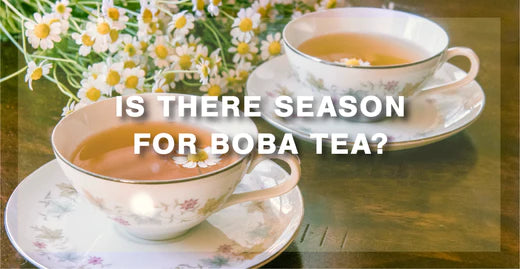Boba tea has the flexibility of having seasonal flavors and offerings; much like many other industries such as fashion, food, and even vacation destinations.
Flavors such as pumpkin spice, peppermint, and cinnamon come to mind when thinking about the cooler fall/winter seasons. Whereas flavors such as refreshing pineapple, passion fruit, coconut come to mind for the warmer spring/summer seasons.
There is no right or wrong way to enjoy boba tea; however, there are definitely flavors that may suit the current season for maximum enjoyment.

Tea leaves overall can be greatly impacted by the season they are harvested. Weather, temperature, moisture, soil quality are just some of the aspects that can affect how the tea can end up tasting. Not only can taste be affected but also the color and aroma of the tea itself. The Spring season is well known to be the first-harvest of the year. This is due to the tea leaves/buds experiencing excellent growth from the nutrients gathered during the winter months. The tea harvested in the Spring season can have a lighter taste profile and soft body while offering a rich aroma. Lighter teas such as green tea and oolong tea are most popular for harvesting during this season.
Most mass-harvested tea comes from the summer season. Summer is when the tea plants experience a bloom of growth. The tea harvested during this season will be bold in flavor while having very little natural sweetness.

The Autumn/Fall season can slow down the growth process of tea plants due to declining temperatures. This season is also very popular for secondary harvesting of lighter teas. Like the Spring season, green and oolong teas are harvested during the Autumn/Fall season. This produces a similar flavor profile to Spring harvested tea leaves; again, showing a lighter taste profile, soft body, and rich aroma.
Tea plants are usually dormant during the Winter months as the plants do not produce leaves. This is a time for the tea plants to gather and store nutrients for the coming seasons.
For a long time, it has been largely debated that global warming and climate change has had an impact on the tea industry. Due to how sensitive tea plants can be to climate and weather, this has been in discussion for a long period of time. Increase in rainfall can cause a diluted taste from the tea leaves as well as colder temperatures can cause frost to accumulate on the tea plant causing the flavor to change as well. Because of these drastic climate changes, the tea that we consume in the future could very well taste quite different from what we can enjoy today or have enjoyed in the past.

The original milk tea is usually sweetened black tea, milk (or other non-dairy options), and of course the star of the show - tapioca pearls! While the original milk tea is enjoyed all year round, there are many other flavors to explore and enjoy.
Of course, we can’t forget the many other topping options; besides tapioca pearls, to complement the amazing boba tea. These different toppings could add a whole different dimension to the boba tea experience. Toppings such as egg pudding, herbal jelly, coffee jelly, red bean, and creme brulee may better suit drinks for the cold weather including milk tea, Thai tea, ube/taro, peanut butter, creme brulee, pumpkin spice, peppermint, or cinnamon flavored drink options.
Like the fall/winter seasons, there are definitely toppings that suit spring/summer tea beverages as well! Some toppings such as popping boba, rainbow jelly, lychee jelly, strawberry heart jelly, blueberry heart jelly, passion fruit dolphin jelly, aloe vera, crystal agar jelly will pair well with refreshing fruity drinks that are best recommended to be enjoyed in the warmer months of the year.
Many boba tea shops will also offer customized levels of ice in your beverage as well as offering hot beverage options. This also creates an impact on how boba tea is enjoyed around the world. Hot beverage options would definitely be best enjoyed during the colder months, while ice cold beverages will be best enjoyed during the warmer months.
Some of my favorite seasonal combinations are classic milk tea or ube taro milk with pearls for the wintertime (some stores can prepare milk tea as a hot beverage, which is an amazing experience whilst being super flavorful). My favorite combination for the warmer months would be a lychee black tea or peach jasmine green tea with lychee jelly. There is no right or wrong time to enjoy the many various combinations of teas and toppings. These are just some recommendations of what may elevate your boba tea experience.
On top of carrying only the finest ingredients and supplies; Fanale Drinks has professional tea experts to guide you on a path towards a seasonal masterpiece that is sure to amaze your clients and customers.

Basilurtea.com, (09/01/2020), Retrieved supporting information from https://www.basilurtea.com/blogs/blog/seasons-change-so-does-the-taste-of-your-tea



